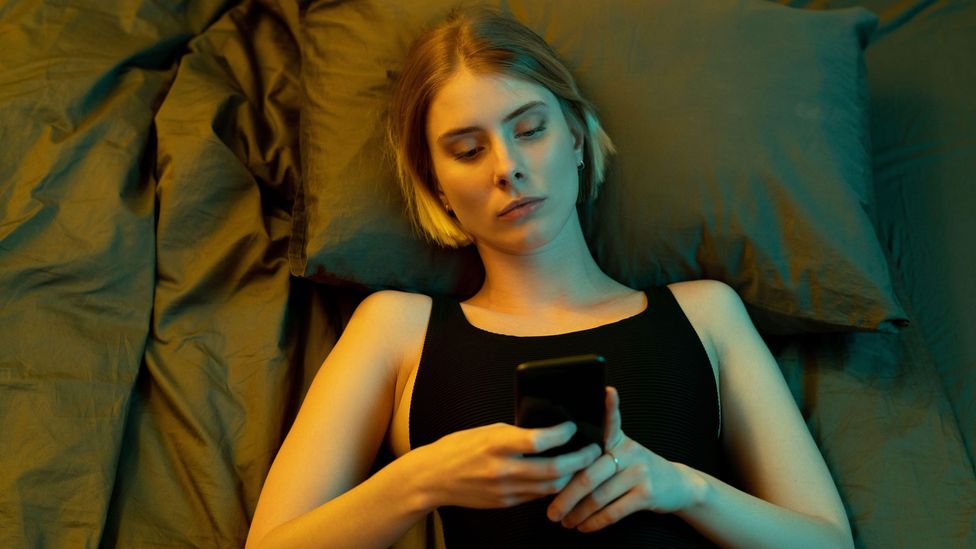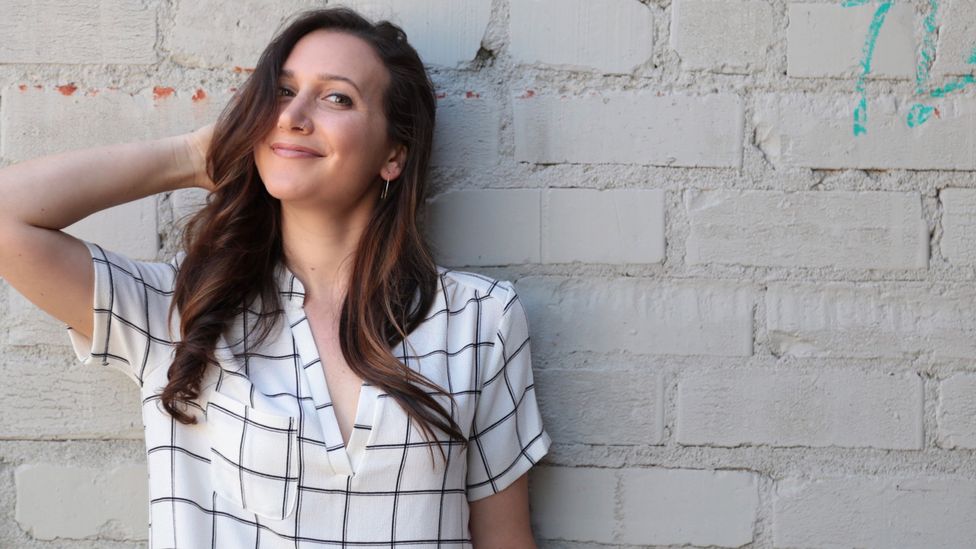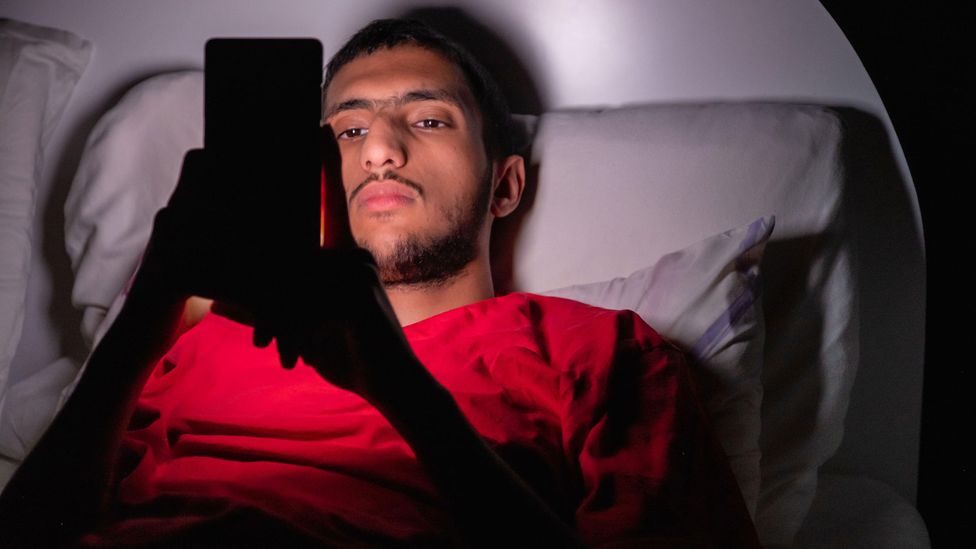
Why does endlessly looking for bad news feel so strangely gratifying – and can we break the habit?
Since the beginning of the pandemic, Emily Bernstein, 29, has been scrolling and scrolling and scrolling. As a Los Angeles-based comedy writer, Bernstein needs to read through Twitter and news sites for material. But it’s not just her job that keeps her reading: it’s the compulsion of ‘doomscrolling’ – trawling through feeds without pause, no matter how bad the news is or how many trolls’ comments she reads.
“I found myself in bed at night scrolling news sites and knowing this is not healthy for me… so why am I doing this?” says Bernstein.
It’s a question many doomscrollers have been asking themselves. There are multiple reasons why the urge to read may be so strong: the feeling of safety in knowledge, especially during difficult times; the design of social-media platforms that constantly refresh and boost the loudest voices; and, of course, the human fascination aspect. “It’s like not being able to look away when you see a car accident,” says Bernstein.
Beyond knowing intuitively that doomscrolling makes us feel awful, studies conducted during the pandemic have corroborated this, linking both anxiety and depression to the consumption of Covid-19 related media and increased time spent on smartphones. So, why do we keep endlessly scrolling – and why can the practice feel oddly soothing? And could there actually be surprising upsides to keeping our eyes locked on our feeds?

“I found myself in bed at night scrolling news sites and knowing this is not healthy for me… so why am I doing this?" – Emily Bernstein (Credit: Henrique Andrade)
The ‘pleasure’ of doomscrolling
Most of us spent some portion of 2020 doomscrolling – so much so that the Oxford English Dictionary named it a word of the year, and even added it to the dictionary.
But doomscrolling isn’t really a new human behaviour. Though the term seems to have entered the public lexicon in early 2020 around the start of Covid-19-related lockdowns, the public has long held the can’t-look-away-from-a-car-crash mentality Bernstein mentions when it comes to consuming news.
“The precursor to going online was that people would watch the 11 o’clock news, [which] was terrifying,” says Dean McKay, a Fordham University psychology professor who specialises in compulsive behaviour and anxiety disorders. That terror, when witnessed from the comfort of the viewer’s home, however, had a potentially calming effect. McKay describes the attitude as people acknowledging “things are pretty horrible, [but] I’m comfortable, so I'm going to be able to sleep well tonight knowing that [I can feel good about] my station in life”.
McKay suggests doomscrolling could be a “modern equivalent”. But, unlike the 2300 news, it doesn’t stop at a fixed hour. During the uniquely uncertain and scary times of 2020, it’s no surprise that people like Bernstein scrolled well into the night. They needed information – at first because little was available about the virus, and then because they got sucked into the never-ending news cycle about it.
As Pamela Rutledge, director of the California-based Media Psychology Research Center, puts it, doomscrolling “really just describes the compulsive need to try and get answers when we’re afraid”. After all, we do have to assess whether new information constitutes a threat. “We are biologically driven to attend to that,” says Rutledge.
Doomscrolling really just describes the compulsive need to try and get answers when we’re afraid – Pamela Rutledge
“Unfortunately, journalism to some degree plays to that tendency,” she adds. Provocative headlines and stories draw in readers because they elicit fear and urgency – as Bernstein says, “There’s a sense of, if I know all the latest news, I can better protect myself and my family.”
This feels reasonable – but most people scroll well past the point of ascertaining any valuable information. Bernstein, for instance, starts doomscrolling sessions by reading the news, but she regularly winds up scrolling through comment sections beneath the articles. “I know it's just going to be a bunch of psychopaths insulting other psychopaths,” she says. “I truly don't know why I do it.” She’s drawn, in a way, to the negativity.
McKay sees a possible evolutionary explanation for this. All human emotional states emerged because they were somehow adaptive. So, wanting to vicariously feel a certain emotion from reading news or comments, like anger or despair, may be a way for us to “practice evolved coping mechanisms” we’ve developed for managing negative life events. Being scared, for example, puts us on high alert, which is useful in dangerous situations. In that sense, says McKay, “[doomscrolling] is almost like an information and strategy gathering approach”.
So, yes, the pandemic has compounded this perceived need for information and news-induced emotions. But people who’ve been unable to socialise or work outside the home during the pandemic have also had more time to scroll. A German survey from late March and early April of 2020 showed a connection between “frequency, duration, and diversity of media exposure” to increased depression symptoms and both general and pandemic-related anxiety. Researchers from Dartmouth College also found increased phone usage linked with more anxiety, depression and sedentary behaviors among college students as Covid-19 concerns increased in March.
 When we feel out of control, doomscrolling can help us feel like we're gathering essential information – no matter how bad the news (Credit: Alamy)
When we feel out of control, doomscrolling can help us feel like we're gathering essential information – no matter how bad the news (Credit: Alamy)
The feed in your head
For Rebecca Linton, 28, who works as a shoe prototyper in Denver, Colorado, doomscrolling during the pandemic has been about “trying to figure out what was going to happen next”, she says.
After the “novelty of being stuck inside and being able to craft all the time” during early lockdowns wore off, Linton found herself “consuming every possible news source about Covid, quarantine and the future that I possibly could”, she says. She often found herself getting sucked into the doomscrolling rabbit hole because she was trying to answer a specific question about what was going on – and that would just lead her to read different angles of the same story. It would also bring up entirely new questions she felt the need to answer, further lengthening her doomscrolling session and creating a self-perpetuating feed of bad news.
This behaviour of dwelling in a kind of endless feed can look a lot like Generalised Anxiety Disorder (GAD), says psychologist Jade Wu: “GAD is basically a Twitter feed of worries in your head.” Since GAD is associated with problems like muscle tensions, fatigue and depression, Wu says she imagines “similar effects” could happen to habitual doomscrollers.
“Doomscrolling is kind of like practicing having GAD,” she says. “If you run everyday, that's going to impact your muscles. If you doomscroll every day, that’s going to impact your psychology and your brain.”
Generalised Anxiety Disorder is basically a Twitter feed of worries in your head – Jane Wu
Doomscrolling also mimics gambling behaviours, because we don’t only scroll for bad news, but also anything uplifting. “We are hooked by the possibility of good news on the horizon,” Wu says (or even just finding a cute puppy video for some temporary relief). She compares doomscrolling, in that sense, to playing the slots. A gambler keeps pressing the lever in hope of winning, though it’s more likely they lose. Losing, for doomscrollers, means exposure to the same bad news, and the negative psychological and physical effects that come with it.
This “variable reinforcement schedule”, says Wu, “is the most addictive pattern of reward”. It’s why slot machines are designed the way they are – and social media feeds, too.
‘The real world outside is not all trolls’
If doomscrolling is slots-level addicting, and probably not the best for our mental health, how do we stop?
Rutledge stresses that awareness of our doomscrolling habits is the best way to quit them. For people on diets, for instance, keeping “food logs”, she says, is “one of the biggest predictors of success” for losing weight because it makes people aware of their current habits. The same could go for doomscrolling. Keep track of how much time you spend doing it to “identify the negative tendency”, Rutledge continues, “then you take steps to change it”.
Rutledge suggests setting a timer to stay alert to how long you’re spending on your phone, establishing a time at night when you put your phone down for the day, or having your partner remind you to turn it off.
That last suggestion works for Linton. Her partner has also got into doomscrolling in the past year, so they “actively support” each other’s efforts to stop, she says. “I find the most helpful thing is to get physical distance,” says Bernstein. “I’ll get off the internet, go on a walk and realise that the real world outside is not all trolls.”

Rebecca Linton has tried to curate her social feeds to make sure she's seeing more good news than before – a kind of antidote to doomscrolling (Credit: Alec Linton)
A future of… hopescrolling?
McKay says he saw a report not long ago that we were entering into the darkest days of the pandemic, “but juxtaposed right next to it is [news] like, ‘here’s how many vaccines are getting rolled out’,” he says. “And suddenly, you have potentially less of a bleak picture.”
That slot machine analogy looks more favourable in this light. Maybe doomscrollers aren’t scrolling to seek out more doom and gloom – they’re doing what McKay tentatively calls “hopescrolling”.
Bernstein even heard the term “joyscrolling” used in recent months, “like on certain days that were particularly great… people were like, ‘I can’t stop joyscrolling!’”.
A day of scrolling through positive news can’t necessarily erase or counteract the habits we’ve formed from months of doomscrolling and their negative effects on our mental wellbeing. However, understanding that scrolling through good news brings us joy could help make us more aware of how our online behaviour affects our emotional state, which Rutledge says is the key to changing our behaviours. Linton, for one, has blocked people who she’s realised are “not bringing valuable information” to her social feeds and has tried to curate her Instagram so it’s full of accounts with more positive content – the kind she can feel good scrolling through.
“I think it's unrealistic to say one day Covid will be over, and I'm never going to [doomscroll] again,” says Bernstein. “I do think it'll decrease, but that's also a thing I realised – I have to put in the work to do that.”

No comments:
Post a Comment